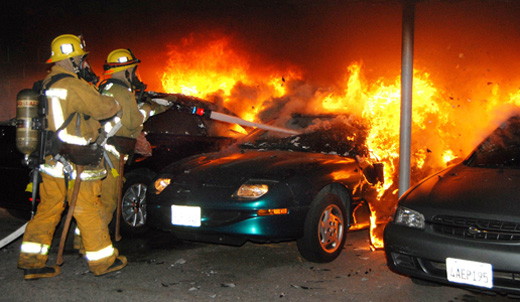
LOS ANGELES (PAI) – New York. Los Angeles. Chicago. St. Louis. Kansas City. Even Scranton, Pa.
From coast to coast, mayors and city councils are hacking away at firefighters’ ranks in desperate attempts to cut budgets and save cash by cutting workers, including IAFF (International Association of Fire Fighters) members and others. While New York led the way in the layoffs – starting in 2011 – they’ve exploded into a major scandal in the nation’s second-largest city, Los Angeles.
That’s because local media uncovered the fact that Mayor Antonio Villaraigosa used the city’s budget ills plus LAFD “excellent” response times to convince his city council to close more than two dozen units, the Los Angeles Fire Fighter said.
The only problem with that was the response time figures: There wasn’t a five-minutes-or-less response 80% of the time, as the mayor and his then-fire chief claimed. It was slightly less than 60%, adds the United Fire Fighters of Los Angeles, IAFF Local 112, citing independent studies.
“Despite our best efforts, the then-Fire Chief and his then chief of staff, Brian Cummings, ultimately prevailed on the city council with their powerful promises of LAFD improvement,” the paper said. So LA, to help close a $300 million-plus gap, shut 18 fire companies, four ambulances, nine emergency medical services districts, three command teams and other units. It downsized LAFD units by 15%.
“For three years now, we rank-and-file Fire Fighters have done our best to make Angelinos aware that deep LAFD budget cuts resulted in tragedies that needn’t have happened,” says Pat McOsker, the local’s president.
“Too many people in need of help have called 911, then waited for thinly stretched firefighters and paramedics who were tied up on other emergencies. There have been some terrible outcomes along the way,” he adds.
McOsker calls the results, including the declining five-minute response rate, “a public safety disaster.” His local is demanding LAFD control be taken out of mayoral hands and transferred to “an elected autonomous fire district board” with the power to hire a fire chief under a long-term contract to bring stability to the department. And McOsker said 150 laid-off LAFD workers should be recalled to duty.
The budgets cuts in LA and elsewhere have been particularly notable since the middle of 2011. That’s when cities, which retained public safety workers thanks to funds from the Obama administration’s stimulus law, had to start laying them off when the money ran out. The GOP-run House’s budget would cut even more from federal fire protection grants – which do not go directly for personnel-IAFF says.
But Los Angeles isn’t the only city where the mayor cut the Fire Fighters. It’s just the one with the biggest controversy. Here’s what has happened elsewhere:
New York Mayor Michael Bloomberg led the cutting parade last year, closing 20 fire companies. So Fire Fighters led 10,000 people, waving American flags, in a protest march across the Brooklyn Bridge to City Hall last June 2. “Public officials are cutting budgets and decimating public safety programs. In difficult times when people have so much insecurity, public safety is something they expect from their government. It is an investment we must make,” IAFF President Harold Schaitberger said then.
“Mayor Bloomberg is putting school children, the elderly, homeowners and business owners throughout the city in grave danger,” Schaitberger warned. The New York Fire Department had approximately 15,000 workers, including managers.
Chicago Mayor Rahm Emanuel, facing a half-billion-dollar budget hole, wants to cut the Fire Department’s ranks, along with other slashes, such as curtailing bus service. IAFF Chicago Local 2 paramedic Rebecca Bolluyt protested in an April 16 letter to the Sun-Times. Chicago has approximately 5,000 fire fighting personnel.
“There are often days we hear over the radio, ‘Is there any available ambulance, anywhere…anyone?'” she wrote. Bolluyt said when a major fire occurs, other areas must cover for the units that respond, or arrive as backups for Fire Fighters whose oxygen tanks run out, or to help rescue victims. “The system works, but we are always concerned that our resources will be overwhelmed-with fatal outcomes,” she added.
St. Louis Mayor Francis Slay, to try to gain control of the Fire Fighters pension fund – for political and fiscal purposes – has attacked the union and cut up to 84 jobs.
City officials “are trying to make Fire Fighters the scapegoat for their years of fiscal incompetence,” IAFF District 2 Vice President Mark Woolbright told the St. Louis Labor Tribune. “Their hope is if they distort the truth long enough and often enough, it’ll resonate with city residents” and damage the high reputation of St. Louis Fire Fighters.
In February, Kansas City, Mo., city manager Troy Schulte said he wanted to cut 162 city workers to close a budget gap, and 105 would be in the fire department. He wanted to pick and choose whom to let go, so that recent hires, cross-trained in both fire fighting and emergency medical services, would not be laid off due to low seniority.
On March 15, Scranton city officials admitted they had no “rapid intervention team” at the ready to rescue hurt or trapped firefighters during a large fire the day before. Nobody died, but the lack of a team was due to budget cuts.
Photo: Los Angeles firefighters battle a car fire Jan. 2. Mike Meadows/AP










